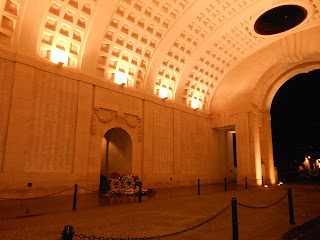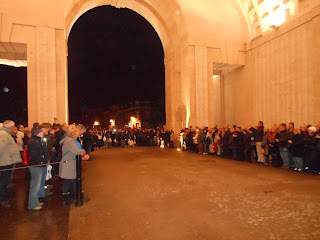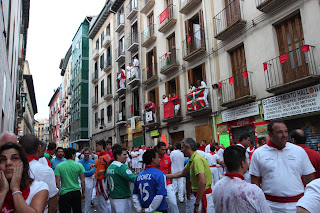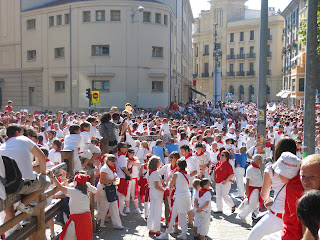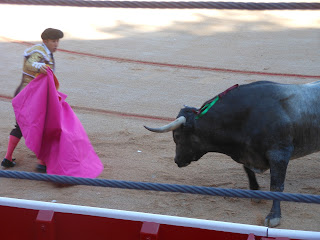Flanders Field, Ieper (Ypres), Belgium
During the Thanksgiving Holiday, we went to Ieper (Ypres), Belgium. Ieper is famous for its role during WWI (1914-1918). Ypres occupied a strategic position during World War I because it stood in the path of Germany's planned sweep across the rest of Belgium and into France from the north. The neutrality of Belgium was guaranteed by Britain; Germany's invasion of Belgium brought the British Empire into the war. The German army surrounded the city on three sides, bombarding it throughout much of the war. To counterattack, British, French, and allied forces made costly advances from the Ypres Salient into the German lines on the surrounding hills.
In the First Battle of Ypres (12 October to 11 November 1914), the Allies captured the town from the Germans. Their use of poison gas for the first time the on 22 April 1915 marked the beginning of the Second Battle of Ypres, which continued until 25 May 1915. They captured high ground east of the town. The gas used was chlorine. Mustard gas, also called Yperite from the name of this city, was also used for the first time near Ypres, in the autumn of 1917.
Ypres was one of the sites that hosted an unofficial Christmas Truce in 1914 between German and British soldiers. Though there was no official truce, roughly 100,000 British and German troops were involved in unofficial cessations of fighting along the length of the Western Front. The first truce started on Christmas Eve, 24 December 1914, when German troops began decorating the area around their trenches in the region of Ypres. The Germans began by placing candles on their trenches and on Christmas trees, then continued the celebration by singing Christmas carols. The British responded by singing carols of their own. The two sides continued by shouting Christmas greetings to each other. Soon thereafter, there were excursions across No Man's Land, where small gifts were exchanged, such as food, tobacco and alcohol, and souvenirs such as buttons and hats. The artillery in the region fell silent. The truce also allowed a breathing spell where recently killed soldiers could be brought back behind their lines by burial parties. Joint services were held. The fraternization carried risks; some soldiers were shot by opposing forces. In many sectors, the truce lasted through Christmas night.
British veterans and civilians created in the 1920s a sacred memory of sacrifice in Belgium. The city of Ypres was made the symbol of all Britain was fighting for and was given a holy aura. The Ypres League transformed the horrors of trench warfare into a spiritual quest in which British and imperial troops were purified by their sacrifice. After the war Ypres became a pilgrimage destination for Britons to imagine and share the sufferings of their men and gain a spiritual benefit.
After the war the town was rebuilt using money paid by Germany in
reparations, with the main square, including the Cloth Hall and town
hall, being rebuilt as close to the original designs as possible (the
rest of the rebuilt town is more modern in appearance). The Cloth Hall
today is home to In Flanders Fields Museum, dedicated to Ypres's role in the First World War.
Today, Ypres is a small city in the very western part of Belgium. Ypres these days has the title of "city of peace" and maintains a close friendship with another town on which war had a profound impact: Hiroshima, Japan. Both towns witnessed warfare at its worst: Ypres was one of the first places where chemical warfare was employed, while Hiroshima suffered the debut of nuclear warfare.
The imposing Cloth Hall
was built in the 13th century and was one of the largest commercial
buildings of the Middle Ages. The structure which stands today is the
exact copy of the original medieval building, rebuilt after the war. The belfry that surmounts the hall houses a 49-bell carillon. The whole complex was designated a World Heritage Site by UNESCO in 1999.
The Gothic-style Saint Martin's Cathedral, originally built in 1221, was also completely reconstructed after the war, but now with a higher spire. It houses the tombs of Jansenius, bishop of Ypres and of Robert of Bethune, nicknamed "The Lion of Flanders".
The German war cemetery of Langemark near Ypres. More than 44,000 German soldiers are buried here. The village was the scene of the first gas attacks by the German army, marking the beginning of the Second Battle of Ypres in April 1915.
During the First Battle of Ypres (1914) in World War I, inexperienced German infantry suffered severe casualties when they made a futile frontal attack on allied positions near Langemark and were checked by experienced French infantry and British riflemen. Many of the German soldiers involved in the Battle of Langemark were schoolboys and students. Legend has it that the German infantry sang the first stanza of what later (1919) became their national anthem "Duetchland, Deutschland uber alles", as they charged.
The Menin Gate Memorial to the Missing in Ypres commemorates those soldiers of the British Commonwealth who fell in the Ypres Salient
during the First World War before 16 August 1917, who have no known
grave. Those who died after that date are commemorated elsewhere.
The memorial's location is especially poignant as it lies on the
eastward route from the town which allied soldiers would have taken
towards the fighting – many never to return. Every evening since 1928
(except for a period during the Second World War when Ypres was occupied
by Germany), at precisely eight o'clock, traffic around the imposing
arches of the Menin Gate Memorial has been stopped while the Last Post is sounded beneath the Gate by the local fire brigade. This tribute is given in honor of the memory of British Empire
soldiers who fought and died there.
The ceremony was prohibited by occupying German forces during the Second World War, but it was resumed on the very evening of liberation – 6 September 1944 – notwithstanding the heavy fighting that still went on in other parts of the town.
During the Thanksgiving Holiday, we went to Ieper (Ypres), Belgium. Ieper is famous for its role during WWI (1914-1918). Ypres occupied a strategic position during World War I because it stood in the path of Germany's planned sweep across the rest of Belgium and into France from the north. The neutrality of Belgium was guaranteed by Britain; Germany's invasion of Belgium brought the British Empire into the war. The German army surrounded the city on three sides, bombarding it throughout much of the war. To counterattack, British, French, and allied forces made costly advances from the Ypres Salient into the German lines on the surrounding hills.
In the First Battle of Ypres (12 October to 11 November 1914), the Allies captured the town from the Germans. Their use of poison gas for the first time the on 22 April 1915 marked the beginning of the Second Battle of Ypres, which continued until 25 May 1915. They captured high ground east of the town. The gas used was chlorine. Mustard gas, also called Yperite from the name of this city, was also used for the first time near Ypres, in the autumn of 1917.
Ypres was one of the sites that hosted an unofficial Christmas Truce in 1914 between German and British soldiers. Though there was no official truce, roughly 100,000 British and German troops were involved in unofficial cessations of fighting along the length of the Western Front. The first truce started on Christmas Eve, 24 December 1914, when German troops began decorating the area around their trenches in the region of Ypres. The Germans began by placing candles on their trenches and on Christmas trees, then continued the celebration by singing Christmas carols. The British responded by singing carols of their own. The two sides continued by shouting Christmas greetings to each other. Soon thereafter, there were excursions across No Man's Land, where small gifts were exchanged, such as food, tobacco and alcohol, and souvenirs such as buttons and hats. The artillery in the region fell silent. The truce also allowed a breathing spell where recently killed soldiers could be brought back behind their lines by burial parties. Joint services were held. The fraternization carried risks; some soldiers were shot by opposing forces. In many sectors, the truce lasted through Christmas night.
British veterans and civilians created in the 1920s a sacred memory of sacrifice in Belgium. The city of Ypres was made the symbol of all Britain was fighting for and was given a holy aura. The Ypres League transformed the horrors of trench warfare into a spiritual quest in which British and imperial troops were purified by their sacrifice. After the war Ypres became a pilgrimage destination for Britons to imagine and share the sufferings of their men and gain a spiritual benefit.
Today, Ypres is a small city in the very western part of Belgium. Ypres these days has the title of "city of peace" and maintains a close friendship with another town on which war had a profound impact: Hiroshima, Japan. Both towns witnessed warfare at its worst: Ypres was one of the first places where chemical warfare was employed, while Hiroshima suffered the debut of nuclear warfare.
The Gothic-style Saint Martin's Cathedral, originally built in 1221, was also completely reconstructed after the war, but now with a higher spire. It houses the tombs of Jansenius, bishop of Ypres and of Robert of Bethune, nicknamed "The Lion of Flanders".
Picture of the Cloth Hall after WWI. Notice the bell tower and compare it to the bell tower in the preceding picture.
Street in Ieper
Church in Ieper
Lieutenant-Colonel John McCrae
(1872-1918)
While serving as a military surgeon in Ypres, Belgium, John McCrae wrote In Flanders Fields, one of the most enduring poems of the First World War. Born in Ontario, Canada, he was practicing medicine in Montreal when he volunteered, in 1914, to join the Canadian Army and was sent to fight in Europe. His stirring poem, written near the trenches at Ypres' Salient provided a strong stimulus to the Allied war effort. The poem was written in his grief after the death of a close friend. McCrae died in 1918 serving at a Canadian army hospital in Boulogne-sur-Mer. His words have made the poppy a lasting symbol of self sacrifice in war.
In Flanders Fields
In Flanders Fields the poppies blow
Between the crosses, row on row.
That mark our place; and in the sky
The larks, still bravely singing, fly
Scarce heard amid the guns below.
We are the Dead. Short days ago
We lived, felt dawn saw sunset glow,
Loved, and were loved, and now we lie
In Flanders fields.
Take up our quarrel with our foe;
To you from failing hands we throw
The torch, be yours to hold it high.
If ye break faith with us who die
We shall not sleep, though poppies grow
In Flanders fields.
First aid station near the front lines where John McCrae worked as a doctor. (Essex Farm)
First aid station at Essex Farm
The cemetery at Essex Farm. The wounded were treated at the front and then taken back to hospitals behind the lines. Those that didn't survive were buried in cemeteries like this one. There are approx 140 cemeteries near Ieper.
A soldier of the Great War...known unto God.
During the First Battle of Ypres (1914) in World War I, inexperienced German infantry suffered severe casualties when they made a futile frontal attack on allied positions near Langemark and were checked by experienced French infantry and British riflemen. Many of the German soldiers involved in the Battle of Langemark were schoolboys and students. Legend has it that the German infantry sang the first stanza of what later (1919) became their national anthem "Duetchland, Deutschland uber alles", as they charged.
This is a mass grave near the entrance. This "comrades' grave" contains 24,917 servicemen, including the Flying Ace Werner Voss.
The 3,000 school
students who were killed during the First Battle of Ypres are buried in a third part of the cemetery.
Adolph Hitler visited the cemetery during WWII to pay tribute to the school boys who gave their lives for Germany during the First World War.
This column marks the battlefield where 18,000 Canadians (on the British left) withstood the first German gas attacks on 22-24 April 1915. 2000 fell and lie buried nearby.
Of the battles, the largest, best-known, and most costly in human
suffering was the Third Battle of Ypres (21 July to 6 November 1917,
also known as the Battle of Passchendaele, in which the British, Canadians, ANZAC, and French forces recaptured the Passchendaele Ridge
east of the city at a terrible cost of lives. After almost five months of fighting,
this battle resulted in nearly half a million casualties to all sides,
and only a few miles of ground won by Allied forces. During the course
of the war the town was all but obliterated by the artillery fire.
Muddy fields leading up to the Passchendaele Ridge
Machine gun nest at Tyne Cot--part of the Third Battle of Ypres (Passchendaele Ridge).
Many of the casualties were buried here.
Mel looking at the headstones
Tyne Cot Cemetery
The Tyne Cot Cemetery contains the grave of 11,954 soldiers. It is the largest cemetery for British Commonwealth forces in the world, for any war.
Tyne Cot Commonwealth War Graves Cemetery and Memorial to the Missing
The cemetery grounds were assigned to the United Kingdom in perpetuity by King Albert I of Belgium in recognition of the sacrifices made by the British Empire in the defense and liberation of Belgium during the war.
The stone wall surrounding the cemetery makes-up the Tyne Cot Memorial to the Missing. Upon completion of the Menin Gate memorial to the missing in Ypres, builders discovered it was not large enough to contain all the names as originally planned. The memorial contains the names of 33,783 soldiers of the UK forces, plus a further 1,176 New Zealanders.
The name of a missing relative on the Memorial Wall
Trench for WWI near Hill 62
Section of trench
Hole left from an Artillery Shell
Trench near Hill 62
German helmets from WW1
The ceremony was prohibited by occupying German forces during the Second World War, but it was resumed on the very evening of liberation – 6 September 1944 – notwithstanding the heavy fighting that still went on in other parts of the town.
The Menin Gate in Ypres records
only the soldiers for whom there is no known grave. As graves are
identified, the names of those buried in them are removed from the Menin
Gate.
The ceremony at the Menin Gate
Tribute to "The Big Bang Theory" Bazinga!!!!!
The ancestral home of Sheldon Cooper!


































